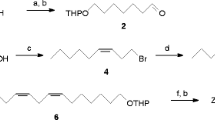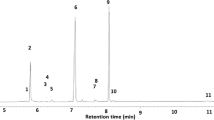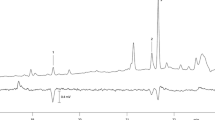Abstract
We analyzed the sex pheromone of the pear fruit moth, Acrobasis pyrivorella, by means of gas chromatography–electroantennographic detection (GC-EAD) and GC–mass spectrometry. Two EAD-active compounds were detected in the pheromone gland extract of females. They were identified as (Z)-9-pentadecenyl acetate (Z9-15:OAc) and pentadecyl acetate (15:OAc). The amounts per female gland (mean ± standard error) of these compounds were 12.9 ± 2.8 and 0.8 ± 0.1 ng, respectively. Synthetic Z9-15:OAc (300 μg) attracted conspecific males in field trapping experiments. When 15:OAc (21 μg; 7% of Z9-15:OAc quantity) was added, the number of males trapped increased significantly. Catch in traps baited with the mixture of these compounds was greater than that in traps baited with 1–3-day-old virgin females. We, therefore, conclude that Z9-15:OAc and 15:OAc are sex pheromone components of this species.




Similar content being viewed by others
References
Adachi, I. 1999. Points of pest control in orchards. Kongetsu-no-nougyo January:25–28 (in Japanese).
Ando, T., Yoshida, S., Tatsuki, S., and Takahashi, N. 1977. Sex attractants for male Lepidoptera. Agric. Biol. Chem. 48:1485–1492.
Baker, T. C., Francke, W., Millar, J. G., Löfstedt, C., Hansson, B., Du, J.-W., Pheran, P. L., Vetter, R. S., Youngman, R., and Todd, J. L. 1991. Identification and bioassay of sex pheromone components of carob moth, Ectomyelois ceratoniae (Zeller). J. Chem. Ecol. 17:1973–1988.
Buser, H. -R., Arn, H., Guerin, P., and Rauscher, S. 1983. Determination of double bond position in mono-unsaturated acetates by mass spectrometry of dimethyl disulfide adducts. Anal. Chem. 55:818–822.
Cardé, A. M., Baker, T. C., and Cardé, R. T. 1979. Identification of a four-component sex pheromone of the female oriental fruit moth, Grapholitha molesta (Lepidoptera: Tortricidae). J. Chem. Ecol. 5:423–427.
Chiba, T. 2000. The peach fruit moth, pp. 45–47, in S. Tatsuki, S. Wakamura, K. Nagata, K. Shimizu, K. Takagi, and H. Sugie (eds.). Guidebook for Application of Synthetic PheromonesJapan Plant Protection Association, Tokyo (in Japanese).
Christie, W. W. 1988. Separation of molecular species of triacylglycerols by high-performance liquid chromatography with a silver ion column. J. Chromatogr. 454:273–284.
EPPO. 2007. Numonia pirivorella. EPPO Quarantine Pests (updated: September, 2007). http://www.eppo.org/QUARANTINE/insects/Numonia_pyrivorella/NUMOPI_ds.pdf.
Heinrich, C. 1956. American moths of the subfamily Phycitinae. Bull. U. S. Natl. Mus. 207:1–581.
Inoue, H. 1982. Pyralidae, p. 398, in H. Inoue, S. Sugi, H. Kuroko, S. Moriuchi, J. Kawabe, and M. Oowada (eds.). Moths of JapanKodansha, Tokyo (in Japanese).
Izawa, H. 2000. Features of mating disruptants: in the case of leafrollers and fruit borers in pear orchards, pp. 76–78, in S. Tatsuki, S. Wakamura, K. Nagata, K. Shimizu, K. Takagi, and H. Sugie (eds.). Guidebook for Application of Synthetic Pheromones Japan Plant Protection Association, Tokyo (in Japanese).
Jinbo, U. 2004–2008. List-MJ: a Checklist of Japanese Moths (updated: May, 2008). http://listmj.mothprog.com (in Japanese).
Konno, Y., Arai, K., Sekiguchi, K., and Matsumoto, Y. 1982. (E)-10-hexadecenal, a sex pheromone component of the yellow peach moth, Dichocrocis punctiferalis Guenée (Lepidoptera: Pyralidae). Appl. Entomol. Zool. 17:207–217.
Makaji, N. 1965. An infestation habitat of the pear fruit moth. Abst. Ann. Meet. Jpn. Soc. Appl. Entomol. Zool. p. 32 (in Japanese).
McDonough, L. M., Averill, A. L., Davis, H. G., Smithhisler, C. L., Murray, D. A., Chapman, P. S., Voerman, S., Dapsis, L. J., and Averill, M. M. 1994. Sex pheromone of cranberry fruitworm, Acrobasis vaccinii Riley (Lepidoptera: Pyralidae). J. Chem. Ecol. 20:3269–3279.
Millar, J. G., Knudson, A. E., McElfresh, J. S., Gries, R., Gries, G., and Davis, J. H. 1996. Sex attractant pheromone of the pecan nut casebearer (Lepidoptera: Pyralidae). Bioorg. Med. Chem. 4:331–339.
Roesler, R. U. 1985. Neue Resultate in der Benennung von Termini bei Phycitinae (Lepidoptera, Pyraloidea) mit Neunnachweisen für Europa. Neue Entomol. Nachr. 17:29–38 (in German).
Roesler, R. U. 1987. Taxonomische Neuorientierung für einige Genera der Phycitinae (Lepidoptera, Pyraloidea). Articulata 2:393–398 (in German).
SAS Institute 1989–2004. JMP version 5.1.1. SAS Institute, Cary.
Shutova, N. N. 1977. The pear pyralid. Zashch. Rast. 9:38 (in Russian).
Struble, D. L., and Arn, H. 1984. Combined gas chromatography and electroantennogram recording of insect olfactory responses, pp. 161–178, in H. E. Hummel, and T. A. Miller (eds.). Techniques in Pheromone ResearchSpringer-Verlag, New York.
Sugie, H., Tamaki, Y., Shirasaki, S., and Kitamura, T. 1984. Further studies on the sex pheromone of the summer fruit tortrix moth, Adoxophyes orana fasciata. Jpn. Appl. Entomol. Zool. 28:156–160 (in Japanese).
Tamaki, Y. 1985. Sex pheromones, pp. 145–191, in G. A. Kerkut, and L. S. Gilbert (eds.). Comprehensive Insect Physiology, Biochemistry, and Pharmacology, vol9. Pergamon Press, New York.
Tamaki, Y., Honma, K., and Kawasaki, K. 1977. Sex pheromone of the peach fruit moth, Carposina niponensis Walsingham (Lepidoptera: Carposinidae): isolation, identification and synthesis. Appl. Entomol. Zool. 12:60–68.
Tanaka, F. 2000. The oriental fruit moth, pp. 37–39, in S. Tatsuki, S. Wakamura, K. Nagata, K. Shimizu, K. Takagi, and H. Sugie (eds.). Guidebook for Application of Synthetic PheromonesJapan Plant Protection Association, Tokyo (in Japanese).
Walker, K. 2006. Pear fruit moth (Acrobasis pyrivorella). Pest and Diseases Image Library (updated: December, 2006). http://www.padil.gov.au.
Witzgall, P., Lindblom, T., Bengtsson, M., and Tóth, M. 2004. The Pherolist. http://www-pherolist.slu.se.
Yamamoto, A. and Ishihara, S. 1991. Synthesis of cis-9-dodecenyl acetate. Japan Patent, P1928533 (in Japanese).
Acknowledgements
JT thanks Dr. Shinichi Yoshimatsu of the National Institute for Agro-Environmental Sciences for advice on the study. JT acknowledges a Grant-in-Aid for Scientific Research No. 19780044 from the Ministry of Education, Culture, Sports, Science and Technology of Japan.
Author information
Authors and Affiliations
Corresponding author
Rights and permissions
About this article
Cite this article
Tabata, J., Minamishima, M., Sugie, H. et al. Sex Pheromone Components of the Pear Fruit Moth, Acrobasis pyrivorella (Matsumura). J Chem Ecol 35, 243–249 (2009). https://doi.org/10.1007/s10886-009-9597-5
Received:
Revised:
Accepted:
Published:
Issue Date:
DOI: https://doi.org/10.1007/s10886-009-9597-5




